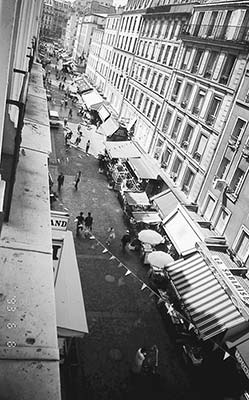
The Art of Parisian Living
 Top Halles Fruits and Vegetables
Top Halles Fruits and Vegetables
 Oldest Building and Charcuterie-Traiteur Jeusselin
Oldest Building and Charcuterie-Traiteur Jeusselin
 A La Mère de Famille Confectionery
A La Mère de Famille Confectionery
Paris is changing quickly, but a stroll down this street introduces you to a thriving, traditional Parisian neighborhood and offers insights into the local culture. Although this is a wealthy district, Rue Cler retains a workaday charm still found in most neighborhoods throughout Paris.
Shopping for groceries is the backbone of everyday life here. Parisians shop almost daily for three good reasons: refrigerators are small (tiny kitchens), produce must be fresh, and it’s an important social event. Shopping is a chance to hear about the butcher’s vacation plans, see photos of the florist’s new grandchild, relax over un café, and kiss the cheeks of friends (for proper kissing etiquette, see “Le French Kiss” sidebar, here).
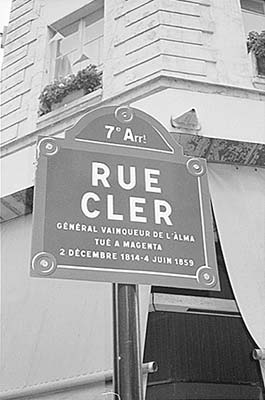
Rue Cler—traffic-free since 1984—offers plenty of space for slender stores and their patrons to spill out onto the street. It’s an ideal environment for this ritual to survive and for you to explore. The street is lined with the essential shops—wine, cheese, chocolate, bread—as well as a bank and a post office. And the shops of this community are run by people who’ve found their niche: boys who grew up on quiche, girls who know a good wine.
For those learning the fine art of living Parisian-style, Rue Cler provides an excellent classroom. And if you want to assemble the ultimate French picnic, there’s no better place. The Rue Cler Walk is the only tour in this guidebook you should start while hungry.
(See “Rue Cler” map, here.)
Length of This Walk: Allow an hour to browse and café-hop along this short walk of two or three blocks.
When to Go: Visit Rue Cler when its markets are open and lively (Tue-Sat 8:30-13:00 & 15:00-19:30, Sun 8:30-12:00, dead on Mon).
Getting There: Start your walk at the northern end of the pedestrian section of Rue Cler, at Rue de Grenelle (right by a bus #69 stop and a short walk from Mo: Ecole Militaire).
Etiquette: Remember that these shops are busy serving regular customers; be careful not to get in the way. Be polite—say “Bonjour, Madame or Monsieur” as you enter and “Au revoir, Madame or Monsieur” when you leave. Get involved and buy something. Before making a purchase, watch the locals to see if self-service is allowed. Many shopkeepers prefer to serve you and don’t want you to touch the goods. If you aren’t sure of the protocol, ask, “Je peux?” (Can I?; zhuh puh). If you know what you want, say, “S’il vous plaît” (Please; see voo play) and point to your choice. For extra credit, add, “Je voudrais” (I would like; zhuh voo-dray). And don’t forget “Merci beaucoup” (Thank you very much; mehr-see boh-koo).

(See “Rue Cler” map, here.)
 Café Roussillon
Café RoussillonThis neighborhood fixture dumped its old-fashioned, characteristic look for the latest café style—warm, natural wood tones, easy lighting, and music. To the left of the door, you’ll see the Tarif des Consommations sign required by French law, making the pricing clear: Drinks served at the bar (comptoir) are cheaper than drinks served at the tables (salles). Notice that there is no café au lait listed. Parisians ask for café crème when they want coffee with steamed milk. Inside, the bar is always busy. The blackboard lists wines sold by the little, 7-centiliter glass (about 2.5 ounces), along with other drinks.
The little late-night grocery next door is one of many neighborhood shops nicknamed dépanneurs (“to help you out of difficulty”). Open nightly until midnight, these Parisian 7-Elevens are usually run by hardworking North Africans willing to keep long hours. Such shops are handy—not cheap. Locals happily pay the higher prices for the convenience dépanneurs provide.
• If you’re shopping for designer baby clothes, you’ll find them across the street at...
 Petit Bateau
Petit BateauThe French spend at least as much on their babies as they do on their dogs—dolling them up with designer jammies. This store is one in a popular chain. Little children around here are really sophisticated. They speak French. And they just aren’t comfortable unless they’re making a fashion statement (such as underwear with sailor stripes).
In the last generation, an aging and shrinking population was a serious problem for Europe’s wealthier nations. But France now has one of Europe’s biggest baby populations—the fertile French average two children per family, compared to 1.6 for the rest of Europe. Babies are trendy today, and the government rewards parents with big tax incentives for their first two children—and then doubles the incentives after that. Since childcare is also subsidized and public school starts at age three, most new mothers get back into the workforce quickly.
Making babies is good business—and revered. Notice how locals give pregnant women the royal treatment: They get priority seating on subways and buses, and they go straight to the front of any line—no waiting on those swollen feet. And the French love to ogle babies. The community celebrates every new addition.
• Cross Rue de Grenelle to find...
 Top Halles Fruits and Vegetables
Top Halles Fruits and VegetablesEach morning, fresh produce is trucked in from farmers’ fields to Paris’ huge Rungis market—Europe’s largest, near Orly Airport—and then dispatched to merchants with FedEx-like speed and precision. Good luck finding a shopping bag—locals bring their own two-wheeled carts or reusable bags. Also, notice how the earth-friendly French resist excessive packaging.
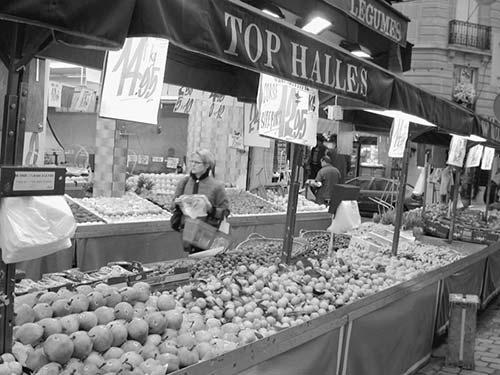
Parisians—who know they eat best by being tuned in to the seasons—shop with their noses. Try it. Smell the cheap foreign strawberries. One sniff of the torpedo-shaped French ones (gariguettes), and you know which is better. Locals call those from Belgium “plastic strawberries”—red on the outside, white on the inside. Find the herbs in the back. Is today’s delivery in? Look at the price of those melons. What’s the country of origin? (It must be posted.) If they’re out of season, they come from Guadeloupe. Many people buy only local products.
The Franprix across the street is a small outpost of a nationwide supermarket chain. Opposite Grand Hôtel Lévêque is a traiteur asiatique. Fast Asian food-to-go is popular in Paris. These shops—about as common as bakeries—have had an impact on traditional Parisian eating habits.
 Le Petit Cler
Le Petit ClerThis small café, a fine choice for lunch or dinner, used to be a tabac (tobacco shop). It’s a good example of how life is changing on Rue Cler. Not so long ago, Brasserie aux PTT, at the opposite end of the rue, was the only place with outdoor tables. Then Café du Marché (described on here) joined in. Now some locals regret that shops are being lost to trendy café crowds.
• Just past Grand Hôtel Lévêque is...
 Wine Bacchus
Wine BacchusShoppers often visit the neighborhood wine shop last, after they’ve assembled their meal and are able to pick the appropriate wine. Wines are classified by region. Most “Parisians” (born elsewhere) have an affinity for the wines of their home region. You can travel throughout France by taking a spin tour of wines on the shelves. Notice the prices: Most are €20 or less, and several sell for under €6. You can get a fine bottle for €12. Wines of the month are stacked in the center and are usually great deals. The helpful clerk (who speaks English) is a counselor who works with your menu and budget to help you select just the right wine. He can even put a bottle of white in the fridge for you to pick up later, though a good selection of chilled wines is available (open until 20:30, except Sun).
• Next door, smell the...
 Fromagerie
FromagerieA long, narrow, canopied cheese table brings the fromagerie into the street. Wedges, cylinders, balls, and miniature hockey pucks are all powdered white, gray, and burnt marshmallow—it’s a festival of mold. The street cart and front window feature both cow (vache) and goat (chèvre) cheeses. Locals know the shape indicates the region of origin (for example, a pyramid shape indicates a cheese from the Loire). And this is important. Regions create the terroir (physical and magical union of sun, soil, and generations of farmer love) that gives the production—whether wine or cheese—its personality. Ooh la la means you’re impressed. If you like cheese, show greater excitement with more las. Ooh la la la la. A Parisian friend once held the stinkiest glob close to her nose, took an orgasmic breath, and exhaled, “Yes, it smells like zee feet of angels.” Go ahead...inhale.
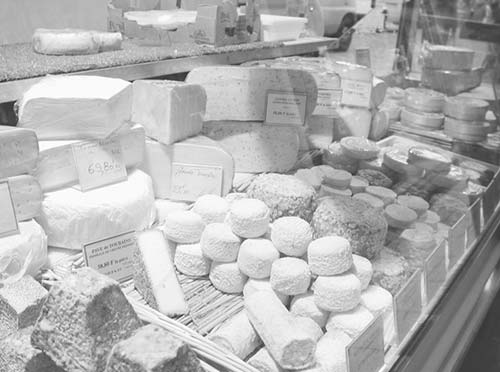
Step inside and browse through more than 200 types of French cheese. A fromagerie is lab-coat-serious but friendly. Also known as a crémerie or a “BOF” (for beurre, oeuf, and fromage), this is where people shop for butter, eggs, and cheese. Just like wines, quality cheeses need to be aged in the cool, humid environment of a cave (cellar). Under the careful watch of an affineur (the “finisher”), some cheeses will rest a few weeks, others for months. Like produce, cheeses are seasonal, as the milk produced by cows or goats changes flavor according to the animal’s varied diet. Ask what’s in season.
In the back room, the shop keeps les meules—big, 170-pound wheels of cheese, made from 250 gallons of milk. The “hard” cheeses are cut from these. Don’t eat the skin of these big ones...they’re rolled on the floor. But the skin on most smaller cheeses—the Brie, the Camembert—is part of the taste. “It completes the package,” says my local friend.
If buying soft cheese, tell the shop when you’re planning to eat it—they’ll squeeze the cheese to make sure it’ll reach la maturité parfaite on the day you want to consume it. One of your author’s favorites is Epoisses, from Burgundy.
At dinner tonight you can take the cheese course just before or instead of dessert. On a good cheese plate you have a hard cheese (perhaps a Comté, similar to a white cheddar), a softer cheese (maybe Brie or Camembert), a bleu cheese, and a goat cheese—ideally from different regions. Because it’s strongest, the goat cheese is usually eaten last.
• Across the street, find the fish shop, known as the...
 Poissonnerie
PoissonnerieFresh fish is brought into Paris daily from ports on the English Channel, 110 miles away. In fact, fish here is likely fresher than in many towns closer to the sea, because Paris is a commercial hub (from here, it’s shipped to outlying towns). Anything wiggling? This poissonnerie, like all such shops, was upgraded to meet Europe-wide hygiene standards.
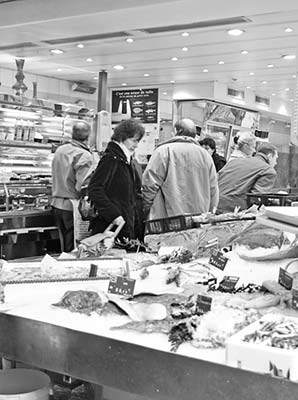
• Next door at Crêperie Ulysée en Gaule (under the awning—get close to see) is a particularly tempting Rue Cler storefront.
 No More Horse Meat
No More Horse MeatThe stones and glass set over the doorway advertise horse meat: Boucherie Chevaline. While today this store serves souvlaki (the family is Greek) and crêpes, the classy old storefront survives from the previous occupant. Created in the 1930s and signed by the artist, it’s a work of art fit for a museum—but it belongs right here, and that’s where it will stay.
Notice that the door is decorated with lunch coupon decals (like chèque déjeuner or ticket restaurant) for local workers. In France, an employee lunch-subsidy program is an expected perk. Employers—responding to strong tax incentives designed to keep the café culture vital—issue voucher checks (worth about €8 each, half of which is paid for by the employee) for each day an employee works in a month. The lunchtime plat du jour is often €8 or under at local cafés. Sack lunches are rare, since a good lunch is sacred...and subsidized.
• Across the street is the...
 Pharmacy
PharmacyIn France, as in much of Europe, pharmacists are the first point of contact for people who are ill. They make the first diagnosis and have the authority to prescribe certain drugs. If it’s out of their league, they’ll recommend a doctor. Pharmacies are also the only place to get many basic medical items, such as aspirin and simple reading glasses.
Inside, you’ll notice locals handing over a green ID, the size of a credit card, with an embedded chip and a photo. This is the all-essential Carte Vitale, the French health insurance card. The national health-care system, Sécurité Sociale, pays about 75 percent of pharmacy, doctor, and hospital bills. Private employer-related insurance, a Mutuelle, covers a varying amount of the rest. Filling a prescription is often completely covered. The last time the World Health Organization ranked health-care systems by country, France came out on top. The French are deservedly proud of their nationalized health care.
To the left of the pharmacy door, notice a condom-dispensing machine for practicing safe sex 24/7 in the City of Light. In France, sex is approached from a practical perspective. Back in the 1990s, when France’s President Mitterrand was the focus of a sex scandal (similar to the one that embroiled Bill Clinton), his infamous response to the prying press was simply, “Et alors?” (So what?)
 Oldest Building and Charcuterie-Traiteur Jeusselin
Oldest Building and Charcuterie-Traiteur JeusselinNext to the pharmacy is Rue Cler’s oldest building (with the two garret windows on the roof). It’s from the early 1800s, when this street was part of a village near Paris and lined with structures like this. Over the years, Paris engulfed these surrounding villages—and now the street is a mishmash of architectural styles.
Occupying the ground floor of this house is Charcuterie-Traiteur Jeusselin. Traiteurs (one who “treats” food) sell mouthwatering deli food to go. Because Parisian kitchens are so small, these gourmet delis are handy, even for those who cook. It lets the hosts concentrate on creating the main course, and then buy beautifully prepared side dishes to complete a fine dinner.
Charcuteries by definition are pork butchers, specializing in sausage, pâté, and ham. The charcuterie business is fiercely competitive in France, with countless cooking contests allowing owners to test their products and show off their skills. Jeusselin proudly displays its hard-won awards by the entrance. One reads: Medaille d’Or du Fromage de Tête du Jambon blanc 2009 (gold medal for head cheese with white ham). Head cheese is a meat jelly made from the head of a pig or cow. Who would brag about that? The French.
The other award—Meilleur Traiteur de Paris, Gault & Millau 2008—is for the “best deli,” determined by the prestigious food-rating organization Gault Millau. Notice also, on the back wall inside, the prominently posted Diplôme de Cordon Bleu—a diploma awarded from the most famous cooking school in France, Cordon Bleu, which used to be in the neighborhood. Even with such credentials, many charcuteries have had to add traiteur services to survive. They’re now selling prepared dishes, pastries, and wines-to-go.
The photogenic Italian charcuterie-traiteur Davoli sits right across Rue Cler. Each day these two places go tête à tête, cooking up plats du jour (specials of the day), advertised on boards outside and inside, and sometimes on their websites. Note the system: Order, take your ticket to the cashier to pay, and return with the receipt to pick up your food.
Both of these charcuteries put out their best stuff just before lunch and dinner (and close in between). If you want a roasted chicken off the spit, pick one up—cooked and hot—at 11:00 or at 17:00, when Parisians buy provisions for that day’s meals.
• A few doors down is...
 Café du Marché and More
Café du Marché and MoreCafé du Marché, on the corner, is the place to sit and enjoy the action (described on here). It’s Rue Cler’s living room, where locals gather before heading home, many staying for a relaxed and affordable dinner. The owner has priced his menu so that residents can afford to dine out on a regular basis, and it works—many patrons eat here five days a week. For a reasonable meal, grab a chair and check the chalk menu listing the plat du jour. Notice how the no-smoking-indoors laws have made outdoor seating and propane heaters a huge hit.
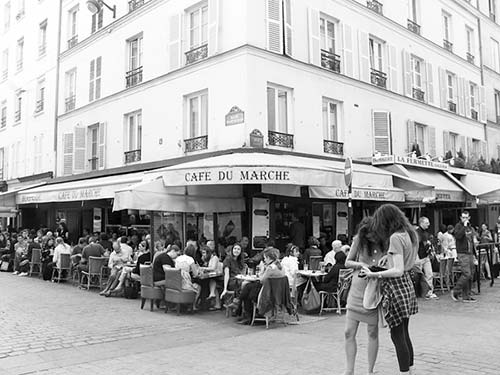
The sterile Leader Price grocery store (across the street) is a Parisian micro-Costco, selling items at discount prices. Because storage space is so limited in Parisian apartments, bulk purchases (à la Costco) are unlikely to become a big deal here. Walk in and notice how much shelf space is dedicated to bottled waters—the French spend almost as much time selecting the terroir of their water as they do for their wine. The latest shopping trend is to stock up on nonperishables online, pick up produce three times a week, and buy fresh bread daily. Compare this storefront with the elegance of the other shops on this street. Its moderne exterior suggests a sneaky bending of the rules. Normally, any proposed building modification on Rue Cler must undergo a rigorous design review in order for the owner to obtain the required permit.
The Paris city government has become enthusiastic about making the town bike-friendly. Notice the loaner bikes parked in the Vélib’ rack. There are hundreds of these self-service stands around town for use by Vélib’ subscribers (for more on this system, see here). The system is intended to let people take short one-way rides by bike rather than car. The city has now done the same thing with electric cars, and it’s a smashing success. Look for Autolib’ cars plugged in at low-profile, curbside charging stations.
• From Café du Marché, hook right and side-trip a couple of doors down Rue du Champ de Mars to visit...
 L’Epicerie Fine
L’Epicerie FineA fine-foods boutique like this stands out because of its gentle owners, Pascal and Nathalie. Their mission in life is to explain to travelers, in fluent English, what the French fuss over food is all about. Say bonjour to Pascal and company. Let them help you assemble a picnic and tempt you with fine gourmet treats, Berthillon ice cream, and generous tastes of caramel, balsamic vinegar, and French and Italian olive oils. Their salted caramels from Normandy and small jars of mustards and jams make good souvenirs.
Across the street is a real estate agency advertising condos and apartments for rent or sale. The touch screen in the window gives the details: the arrondissement (neighborhood), if it’s an apartment or condo, how many rooms (pieces—includes living and family rooms), square meters (25 square meters would be about 5 by 6 yards—the size of a spacious hotel room), and the monthly rent or sales price.
• Return to Rue Cler. The neighborhood bakery on the corner is often marked by a line of people waiting to pick up their daily baguette.
 Artisan Boulangerie
Artisan BoulangerieSince the French Revolution, the government has regulated the cost of a basic baguette (meaning “wand” or “stick” of bread). By law, it must weigh 250 grams and consist of only four ingredients: flour, yeast, salt, and water. Parisians specify their preferences when they place a boulangerie order—some like their baguette well done, and others prefer it more doughy. More than one trip a day to the bakery is normale in Paris, as a good baguette can become stale in a matter of hours. To keep it fresh, wrap it in a cloth, never a plastic bag.
Locals debate the merits of Paris’ many boulangeries, often remaining loyal to their local bread-baker. Boulangeries must make their bread on the premises (otherwise, they can’t be called a boulangerie). I know of hotels that won’t serve breakfast until the corner bakery opens, to avoid having to set out yesterday’s bread and croissants for their guests. Each spring, the city hosts a competition for the Best Baguette of Paris. The top prize? A cash award of €4,000 and the honor of providing the French president with baguettes for the coming year. This annual contest is the equivalent of Michelin’s star system for bakeries.
It’s said that a baker cannot be good both at bread and at pastry—at cooking school, they major generally in one or the other. A Boulangerie diploma covers bread and viennoiserie, which includes all the breakfast items (croissants, pain au chocolat, and so on), and these bakers usually do tartes and anything with choux pastry (éclairs, for example). If you get a Pâtisserie diploma, your forte is pastries like macarons and fancy creamy cakes and chocolate creations. You can usually tell whether a boulanger or pâtissier runs a place by what a shop has more of—and what’s selling best.
At Artisan Boulangerie, the baker bucks the trend and seems equally skilled in the two specialties. Rue Cler regulars agree that this man makes both good bread and delicious pastries.
• A bit farther along is...
 A La Mère de Famille Confectionery
A La Mère de Famille ConfectioneryThis shop has been in the neighborhood for 30 years. The owner sells modern treats, but has always kept the traditional candies, too. “The old ladies, they want the same sweets that made them so happy 80 years ago,” she says. You can buy “naked bonbons” right out of the jar and chocolate by the piece (about €0.75 each). You’re welcome to assemble a small assortment.
Until a few years ago, the chocolate was dipped and decorated right on the premises. As was the tradition in Rue Cler shops, the merchants resided and produced in the back and sold in the front.
• Next door, you’ll find a...
 Mephisto Shoe Store
Mephisto Shoe StoreShoe stores are almost as popular as bakeries in this city of footwear-loving fashionistas. (French-made Mephistos are cheaper here than in the US.) You may see the locals checking out your “foreign” shoes. In a city where many people don’t have cars, good shoes matter. The average Parisian’s daily life is active: walking to the Métro, to lunch, to the shops after work, and then home (probably up several flights of stairs). No need for the gym with this routine. (Hence, gyms here are rare, expensive, and not well-maintained.)
• Across the street is...
 Cler Fleurs
Cler FleursAlmost all Parisians who reside in the city center live in apartments or condos. Even the biggest, most luxury-laden city home shares walls with neighbors and has no yard. A lucky few may have access to a courtyard, but almost no one has a private garden. Parisians spend small fortunes bringing nature into their homes with plants and fresh flower arrangements. Notice the flower boxes on balconies—you work with what you have. When visiting friends in Paris, it’s de rigueur to give a gift of flowers, and it’s good form to have them delivered before you show up. Avoid chrysanthemums, as they are reserved for funerals.
Pop into the butcher shop a few doors down for a graphic peek at how far Parisians like to venture from beef when it comes to meat. You’ll find everything here that’ll be listed on your menu tonight (rabbit, lamb, duck, veal, and pigeon) and maybe even more (pig’s ears, liver, brain, and tripe—very photogenic).
• Walk on to the end of Rue Cler, where it hits a bigger street flooded with cars and buses.
 City Info Post
City Info PostAn electronic signpost (10 feet up) directs residents to websites for local information—transportation changes, surveys, employment opportunities, community events, and so on. Notice the big glass recycling bin nearby and the see-through garbage sacks. In the 1990s, Paris suffered a rash of trash-can bombings. Bad guys hid rigged camp-stove canisters in metal garbage cans, which shredded into deadly “shrapnel” when they exploded. City authorities solved this by replacing metal cans with translucent bags.
• Across the busy Avenue de la Motte-Picquet is a tabac.
 Tabac La Cave à Cigares
Tabac La Cave à CigaresJust as the US has liquor stores licensed to sell booze, the only place for people over 16 to buy tobacco legally in France is at a tabac (tah-bah) counter. Tobacco counters like this one are a much-appreciated fixture of each neighborhood, offering lots of services (and an insight into the local culture). Even nonsmokers enjoy perusing the wares at a tabac. Notice how European laws require a bold warning sign on cigarettes—about half the size of the package—that says, bluntly, fumer tue (smoking kills).
Tabacs serve their neighborhoods as a kind of government cash desk. All sell stamps and some sell public-transit tickets. This tabac also sells the Paris Museum Pass at no added charge—très handy. Locals pay for parking meters in tabacs by buying a card...or pay fines if they don’t. Like back home, the LOTO is a big deal—and a lucrative way for the government to tax poor and less-educated people.
American smokers may not be able to resist the temptation to pick up a petit Corona—your chance to buy a fine Cuban cigar.
• Your walk is done. I’m headed back to the bakery. But if you’re ready to move on, the Ecole Militaire Métro stop is just down Avenue de la Motte-Picquet to the right. If you bought a picnic along this walk, here are two good places to enjoy it: Leaving Rue Cler, turn left on Avenue de la Motte-Picquet for the Army Museum (find the small park after crossing Boulevard de la Tour Maubourg). Or, turn right to reach the Champs de Mars park (and the Eiffel Tower).